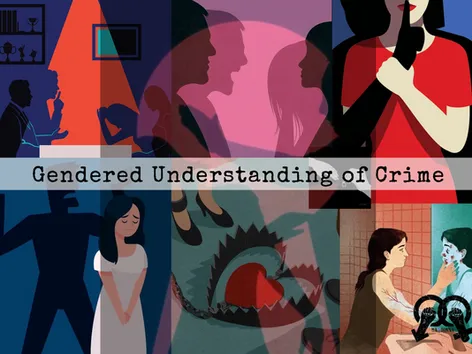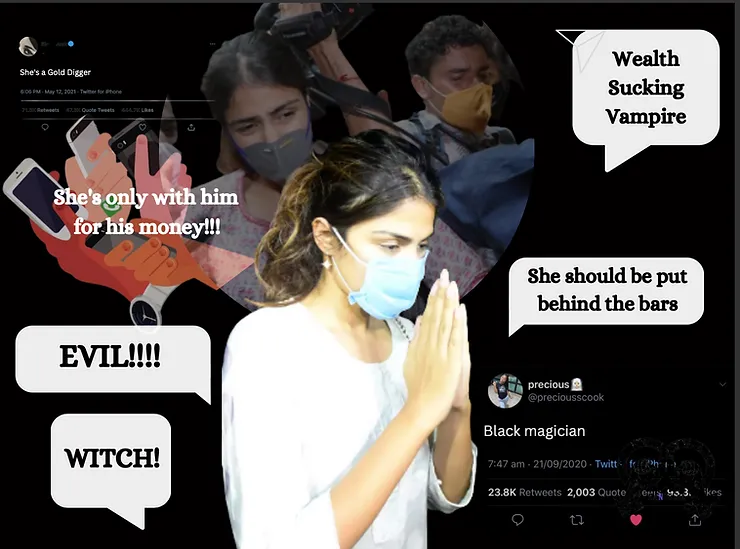Learning Outcomes:
- What is the 'Pick-me-girl' phenomenon and its various types
- What are the reasons for the occurrence of this phenomenon with particular emphasis on 'Male Gaze Theory'
- Insights into whether every woman is a 'pick me girl' and how should that make us feel
- To recognise the differential societal treatment and media coverage meted out to female criminals and male criminals
- To recognise how such treatment affects women criminals’ rehabilitation in the society
- To understand the sexist connotations of the public outcry against and narratives around female criminals
- To suggest solutions to improve the situation

In 2020, when Bollywood actor Sushant Singh Rajput died due to suicide, media narratives posed his then-girlfriend Rhea Chakraborty as a primary suspect, even when she was not directly involved. In a vitriolic hate campaign that followed in the months to come, Chakraborty was portrayed as a gold-digger, black magician, vampirist, and a simply evil woman, who served as a reminder to our patriarchal society about what women should not be. In direct contrast to this, was the suicide case of another Bollywood actress, Jiah Khan, in 2015. When her relatives alleged the involvement of her then-boyfriend Suraj Pancholi, he was spared of the vitriolic and sexist media hatred that Chakraborty went through. While he also went through significant negative press, he was never attacked personally and attributed derogatory labels because of his gender.
If you think this was a one-off incident, then you're highly mistaken. While the facts and circumstances of each case differ, the media narratives surrounding these cases follow a largely similar template. They are gendered!

Gendering Crimes & Criminals
According to the FBI, 73% of all incarcerated people in the USA in 2014, were men. Around a whopping 89.5% of violent crimes like homicides, murders and sexual assaults are committed by men. Such statistics are used by socio-biologists and biological essentialists to argue that somehow, crime is a gendered activity. They contend that women are hard-wired to be naturally nurturing and passive, and hence less likely to commit crimes. Men, on the other hand, are believed to be naturally aggressive and violent, and hence more likely to commit brutal crimes. However, this is merely a deeply sexist notion, with no scientific evidence to back it up.

Women can be as likely as men to commit crimes. In fact, according to Crown Prosecution Services, women are overrepresented as perpetrators of hate crimes against disabled people. Some of the most hardened criminals around the world have been women. They can be serial killers, murderers, sexual assaulters, terrorists, etc. Be it Jolly Shaju, who killed her entire family of 6 over a span of 14 years through slow mercurial poisoning, or Samantha Lewthwaite, who was involved in the militant recruitment of women in terrorist organizations like ISIS and Boko Haram, women have always been criminals. However, when we subscribe to sexist and patriarchal thinking, we find it hard to believe that women are not limited to the narrow mould of passivity and nurturing instincts patriarchy has attributed to them.
The idea of a woman being violent, even murderous, is shocking to a patriarchal society because violence is popularly depicted as a courageous (and by extension manly) virtue. That’s why, when an entire culture attributes the moral hegemony of violence and crime to heterosexual men exclusively, the media and society tend to treat female and male crimes differently.
Popular Narratives about Female Criminals
For example, serial killer Myra Hindley, who was involved in the cold-blooded murders of children during the 70s, was not critiqued for her heartless crimes, but for breaking the character of a nurturing maternal figure allocated to her (and other women) by the society. She was also criticised for her sexual encounters with women by the homophobic culture and media, who dubbed her sexual orientation as evidence of her deviance. Another case was that of Amanda Knox, who was initially convicted of murdering another woman in Italy, in 2007. While she had her conviction definitively quashed in 2015 by the Italian supreme court of cassation, it was not before every detail of her sex life had been minutely examined and laid before the public via the internet tabloids.

Impact on Criminal Rehabilitation
Due to patriarchal and sexist assumptions, our society and culture adopt a highly unforgiving attitude towards female law offenders. This inevitably impacts the rehabilitation process of female criminals. It has been recognised by the courts that the media can influence legal outcomes (Esteal, et al., 2015). For example, The English Court of Appeal held that the media’s reporting (and police actions) in the famous case of the Taylor sisters, who murdered one of their sister’s lovers, had ‘convicted [the sisters] of the murder from the start’ (Naylor, 1994). This is largely true of media trials, which, unlike the free and fair court trials, function in a gendered societal landscape, with stereotypical and traditional images of the masculine and the feminine. More often than not, media coverage of female criminals embarks on a witch hunt of sorts, where such criminals are not even given a fair chance to present their case. They are almost always perceived to be guilty from the get-go.
When the media seems to assume their guilt well before the trial, the verdicts and sentences by the courts also correlate with such framing. The coverage of Rosemary West, an English serial-killer, is a good illustration:
The guilty verdicts against [her] … were pre-empted by newspaper headlines … [that] ignored the legal arguments and focused solely on constructing Rose’s sexuality as debauched.
[Storrs, 2004, p. 17]
Hence, in the midst of such an unyielding environment, female law offenders, convicted or acquitted, find it increasingly difficult to enmesh positively within the society after finishing their sentence. The shadow of the vitriolic hatred and derogatory labels that they were subjected to by the sexist media, continue to loom large, well into their new afterlife. For instance, in the case of Maxine Carr, who was indirectly involved in the murder of two 10-year-old girls, the public vitriol and vilification was such that she had to be given a fresh identity and placed in a safe house upon her release from prison.
The Way Forward: Suggestions & Solutions

References
Dwyer, Kate. “There’s a Reason We’re so Obsessed with Female Killer Shows.” Refinery 29, August 23, 2019. https://www.refinery29.com/en-us/female-killers-obsession-why-women-kill.
Easteal, Patricia, Lorana Bartels, Noni Nelson, and Kate Holland. “How Are Women Who Kill Portrayed in Newspaper Media? Connections with Social Values and the Legal System.” Women’s Studies International Forum 51 (2015): 31–41. https://doi.org/10.1016/j.wsif.2015.04.003.
Kennedy, Helena. “The Myth of the She-Devil: Why We Judge Female Criminals More Harshly.” The Guardian, October 2, 2018. https://amp.theguardian.com/uk-news/2018/oct/02/the-myth-of-the-she-devil-why-we-judge-female-criminals-more-harshly.
Quaramby, Katharine. “Why Are We Shocked When Women Commit Violent Crimes?” The Independent, June 2, 2016. https://www.independent.co.uk/news/science/archaeology/features/some-women-do-kill-abuse-and-torture-a7056136.html.
Weare, Siobhan. “‘The Mad’, ‘The Bad’, ‘The Victim’: Gendered Constructions of Women Who Kill within the Criminal Justice System.” Laws 2, no. 3 (2013): 337–61. https://doi.org/10.3390/laws2030337.

Charu Pawar (Research Head, Mandonna) is a 20-year-old empath, trying to navigate through the patriarchal world with a feminist heart. Find her debating about “smashing the patriarchy” over a plate of momos in college lawns, dingy tea shops, and practically everywhere else…




